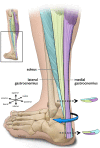Foundational Principles and Adaptation of the Healthy and Pathological Achilles Tendon in Response to Resistance Exercise: A Narrative Review and Clinical Implications
- PMID: 36012960
- PMCID: PMC9410084
- DOI: 10.3390/jcm11164722
Foundational Principles and Adaptation of the Healthy and Pathological Achilles Tendon in Response to Resistance Exercise: A Narrative Review and Clinical Implications
Abstract
Therapeutic exercise is widely considered a first line fundamental treatment option for managing tendinopathies. As the Achilles tendon is critical for locomotion, chronic Achilles tendinopathy can have a substantial impact on an individual's ability to work and on their participation in physical activity or sport and overall quality of life. The recalcitrant nature of Achilles tendinopathy coupled with substantial variation in clinician-prescribed therapeutic exercises may contribute to suboptimal outcomes. Further, loading the Achilles tendon with sufficiently high loads to elicit positive tendon adaptation (and therefore promote symptom alleviation) is challenging, and few works have explored tissue loading optimization for individuals with tendinopathy. The mechanism of therapeutic benefit that exercise therapy exerts on Achilles tendinopathy is also a subject of ongoing debate. Resultingly, many factors that may contribute to an optimal therapeutic exercise protocol for Achilles tendinopathy are not well described. The aim of this narrative review is to explore the principles of tendon remodeling under resistance-based exercise in both healthy and pathologic tissues, and to review the biomechanical principles of Achilles tendon loading mechanics which may impact an optimized therapeutic exercise prescription for Achilles tendinopathy.
Keywords: exercise therapy; mechanotransduction; physical therapy modalities; rehabilitation; tendinopathy; tendons.
Conflict of interest statement
The authors declare no conflict of interest.
Figures


Similar articles
-
Evidence-Based High-Loading Tendon Exercise for 12 Weeks Leads to Increased Tendon Stiffness and Cross-Sectional Area in Achilles Tendinopathy: A Controlled Clinical Trial.Sports Med Open. 2022 Dec 20;8(1):149. doi: 10.1186/s40798-022-00545-5. Sports Med Open. 2022. PMID: 36538166 Free PMC article.
-
Applying physical science principles to mid-substance Achilles tendinopathy and the relationship to eccentric lengthening exercises.Scand J Med Sci Sports. 2018 Mar;28(3):1159-1165. doi: 10.1111/sms.12978. Epub 2017 Oct 4. Scand J Med Sci Sports. 2018. PMID: 28948634
-
A novel murine muscle loading model to investigate Achilles musculotendinous adaptation.J Appl Physiol (1985). 2021 Apr 1;130(4):1043-1051. doi: 10.1152/japplphysiol.00638.2020. Epub 2021 Feb 11. J Appl Physiol (1985). 2021. PMID: 33571057 Free PMC article.
-
Adaptation of Tendon Structure and Function in Tendinopathy With Exercise and Its Relationship to Clinical Outcome.J Sport Rehabil. 2020 Jan 1;29(1):107-115. doi: 10.1123/jsr.2018-0353. J Sport Rehabil. 2020. PMID: 30860421 Review.
-
Achilles Tendinopathy Pathogenesis and Management: A Narrative Review.Int J Environ Res Public Health. 2023 Aug 30;20(17):6681. doi: 10.3390/ijerph20176681. Int J Environ Res Public Health. 2023. PMID: 37681821 Free PMC article. Review.
Cited by
-
Effectiveness of Kinesiotherapy in the Treatment of Achilles Tendinopathy-A Narrative Review.Sports (Basel). 2024 Jul 25;12(8):202. doi: 10.3390/sports12080202. Sports (Basel). 2024. PMID: 39195578 Free PMC article. Review.
-
Optimizing repair of tendon ruptures and chronic tendinopathies: Integrating the use of biomarkers with biological interventions to improve patient outcomes and clinical trial design.Front Sports Act Living. 2023 Jan 6;4:1081129. doi: 10.3389/fspor.2022.1081129. eCollection 2022. Front Sports Act Living. 2023. PMID: 36685063 Free PMC article. Review.
-
Understanding the impact of Achilles lipid content on tendon mechanical parameters: a cross-sectional study of people with familial hypercholesterolemia and healthy controls.BMC Musculoskelet Disord. 2025 Feb 22;26(1):183. doi: 10.1186/s12891-025-08430-4. BMC Musculoskelet Disord. 2025. PMID: 39987058 Free PMC article.
-
Current Concepts in the Nonoperative Management of Achilles Tendon Pathologies: A Scoping Review.J Clin Med. 2025 Jul 4;14(13):4736. doi: 10.3390/jcm14134736. J Clin Med. 2025. PMID: 40649111 Free PMC article. Review.
-
Smart Chemical Sensor and Biosensor Networks for Healthcare 4.0.Sensors (Basel). 2023 Jun 20;23(12):5754. doi: 10.3390/s23125754. Sensors (Basel). 2023. PMID: 37420917 Free PMC article.
References
-
- De Vos R.-J.J., van der Vlist A.C., Zwerver J., Meuffels D.E., Smithuis F., Van Ingen R., van der Giesen F., Visser E., Balemans A., Pols M., et al. Dutch multidisciplinary guideline on Achilles tendinopathy. Br. J. Sports Med. 2021;55:1125–1134. doi: 10.1136/bjsports-2020-103867. - DOI - PMC - PubMed
-
- Martin R.L., Chimenti R., Cuddeford T., Houck J., Matheson J.W., McDonough C.M., Paulseth S., Wukich D.K., Carcia C.R. Achilles pain, stiffness, and muscle power deficits: Midportion achilles tendinopathy revision 2018. J. Orthop. Sports Phys. Ther. 2018;48:A1–A38. doi: 10.2519/jospt.2018.0302. - DOI - PubMed
-
- Ackermann P.W., Hart D.A. Metabolic Influences on Risk for Tendon Disorders. Springer International Publishing; Cham, Switzerland: 2016.
Publication types
Grants and funding
LinkOut - more resources
Full Text Sources
Research Materials

